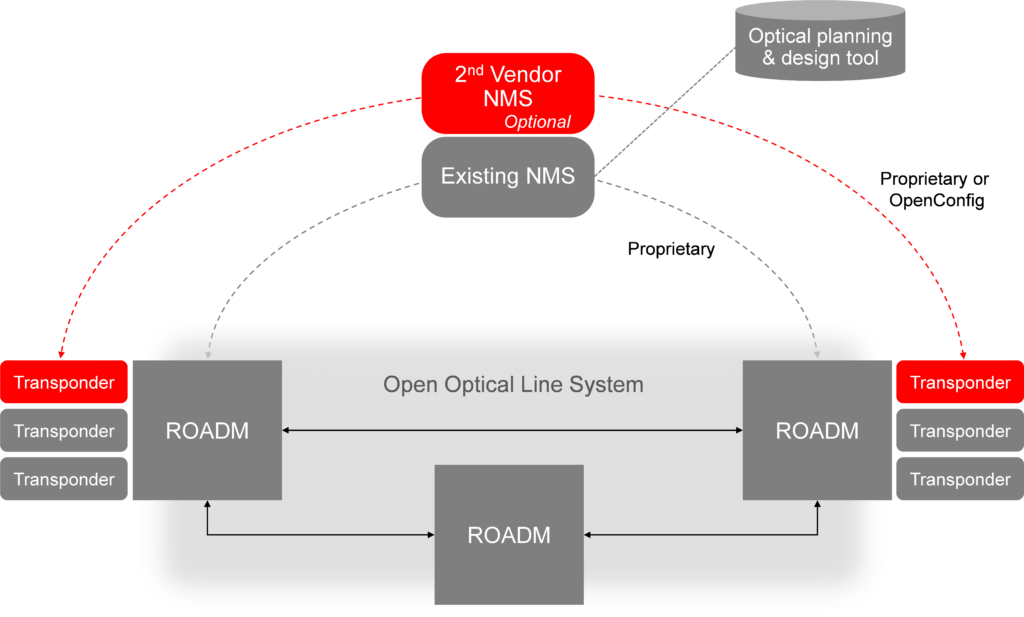The Open Optical Networking Blogs, Part 1

In this blog series, Fujitsu’s Francois Moore explores the key issues and current developments in open optical networking. The topics addressed include Adding Alien Wavelengths, Controlling Multi-Vendor Optical Networks, Opening the ROADM network, Disaggregating the Transponder, and Planning with Multi-Vendor Optical Design Tools.
The simplest entry point into an open optical network is the deployment of alien wavelengths. The idea is to select a transponder from a different vendor than the underlying ROADM and use a pair of them to activate a book-ended wavelength across the network. This is depicted in Figure 1 below where the transponders in red are alien transponders.

This application requires minimal interoperability requirements between the ROADM and the alien transponder. Both the ROADM and the alien transponder typically comply with the DWDM ITU C-Band grid specification. Carriers also need to ensure that the transponder’s launch power is within the range supported by the ROADM, but this is typically not an issue as most transponders typically launch within a narrow power value centered at 0 dBm.
Value for the service provider
Alien wavelengths can provide several benefits to a service provider:
- Supplier diversity. The freedom to procure transponders from multiple vendors helps to alleviate supply chain disruptions, mitigate long lead times, and potentially secure lower pricing from the incumbent ROADM vendor.
- Keep service offerings competitive. Vendor lock-in restricts a service provider to choose only from that vendor’s transponder portfolio, which may or may not be what the customer needs. Perhaps a similar transponder from another vendor has a richer feature set, or perhaps they have a new transponder that isn’t even on the roadmap of the incumbent vendor. Capturing market share is much easier when one can deploy the most appropriate products that fit customers’ requirements.
- Streamlined operations. Many networks today are the result of mergers and acquisitions in the industry over the past several years. The resulting network is often composed of a series of self-contained sub-networks or domains, each implemented using a different vendor. Alien wavelengths allow these service providers to consolidate the number of active transponder vendors by using the same vendor as native wavelengths in their part of the network, and as alien wavelengths outside their domain.
Actual Deployments
Fujitsu has supported several alien wavelength deployments – in fact, both as the alien transponder vendor, and as the native ROADM vendor.
Marcatel, a service provider based in Mexico, is one example. The Fujitsu 1FINITY™ T300 transponder was first deployed several years ago over their existing ROADM infrastructure. This allowed Marcatel to identify an alternate supplier for transponders and the 100 G QPSK alien wavelengths.
Another example is BB Backbone, a subsidiary of SoftBank Corp. in Japan. Their BBB Spectrum service, launched in July 2019, supports transponders from nine different vendors deployed over a Fujitsu 1FINITY L100 ROADM network. Customers lease an optical channel and can provide their own transponders. Most active wavelengths in this network are in fact alien wavelengths.
Potential Limitations & Challenges
Alien wavelengths do have their limitations and can create new challenges. Three key issues need to be considered:
- Network management & OSS. Two vendors, two parallel management systems. Is it necessary to integrate the two (or more) systems? Not necessarily – the full answer depends on the number of alien wavelengths deployed, the network complexity, and internal operational processes. Most small-scale deployments can in fact be handled without integration and with a few tweaks to existing operational processes. At a certain point however, the benefits of a single, seamless system outweigh the costs of integration. An upcoming blog, Controlling Multi-Vendor Optical Networks, will outline integration options that help to inform the cost/benefit decision.
- Multi-vendor Integration and Support. If and when integration of management systems is deemed necessary, different integration paths leveraging a variety of open standards and interfaces are possible. Engaging an experienced systems integrator in this area is crucial to a successful outcome due to accelerating developments in open optical networking standards, interfaces, and APIs. Fujitsu has developed a set of procedures, scripts, workarounds, and techniques for resolving frequently encountered problems through our alien wavelength deployments, trials, and participation in interoperability testbeds and industry working groups. Qualifying and choosing the right partner is a decision that requires careful consideration.
- Optical Planning and Design Tool. Wavelength planning tools model the optical network, calculate reachability, and recommend transponder configuration settings. To do this, detailed technical parameters of the alien transponder must be entered into the planning tool – but vendors do not release this proprietary data. The next blog in this series, Controlling Multi-Vendor Optical Networks, explores current developments in this area.
While small-scale alien wavelength deployments can be simple and straight forward, large scale deployments will most definitely require research and careful planning. This application note, Simplifying Alien Wavelength Deployment, offers a more detailed look at adding alien wavelengths.